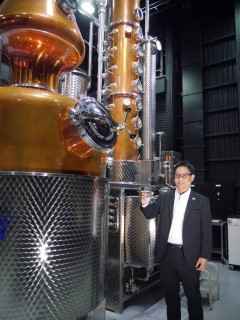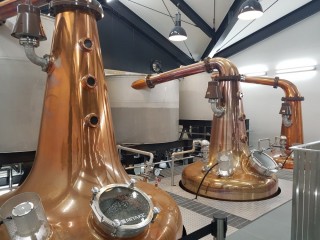Loading
Search
▼ New Distilleries Spring Forth as Japan’s Whisky Boom Continues
- Category:Gourmet
As the reputation of Japanese whisky has spread across the globe, the number of distilleries in Japan has risen to meet demand. In 2011, there were only nine nationwide, but that number has since increased to more than 20.
While goliaths such as Suntory and Nikka currently lead the category, the craft distillery scene is booming and, as competition rises, so does the quality and level of experimentation taking place at each distillery.
Some of the new cohort of distilleries are tiny (the Nagahama Distillery in Shiga Prefecture is just 8 tsubo, or 26½-square-meters) while others only produce whisky as a side venture to their main products, such as sake and shōchū. But many are chomping at the bit to get into the market, fully committing to whisky production.
Two of the more exciting distilleries to open this year are the Kanosuke Distillery in Kagoshima Prefecture and the Sakurao Distillery in Hiroshima Prefecture. Both are pursuing innovative new whiskies, playing on regional variation to create local flavors.
Kanosuke, which sits close to Kagoshima’s Fukiagehama beach is minimalistic. Built from light-colored wood and with a beige brick facade, it blends well with the neighboring sand and sea.
While goliaths such as Suntory and Nikka currently lead the category, the craft distillery scene is booming and, as competition rises, so does the quality and level of experimentation taking place at each distillery.
Some of the new cohort of distilleries are tiny (the Nagahama Distillery in Shiga Prefecture is just 8 tsubo, or 26½-square-meters) while others only produce whisky as a side venture to their main products, such as sake and shōchū. But many are chomping at the bit to get into the market, fully committing to whisky production.
Two of the more exciting distilleries to open this year are the Kanosuke Distillery in Kagoshima Prefecture and the Sakurao Distillery in Hiroshima Prefecture. Both are pursuing innovative new whiskies, playing on regional variation to create local flavors.
Kanosuke, which sits close to Kagoshima’s Fukiagehama beach is minimalistic. Built from light-colored wood and with a beige brick facade, it blends well with the neighboring sand and sea.
At the visitor center, I meet Yoshitsugu Komasa, Kanosuke’s master distiller, executive director and the fourth-generation owner of the distillery’s parent company, Komasa Jyozo Co., a renowned shōchū manufacturer. Komasa tells me that the company’s roots stretch to 1883, when his great-grandfather Ichisuke Komasa started producing high quality shōchū in the region.
The name of the new whisky distillery is taken from Ichisuke’s son, Kanosuke, who was a pioneer of shōchū. Looking to change the image of the drink — seen as cheap and flavorless — Kanosuke created Japan’s first barrel-aged rice shōchū, the 6-year-old Mellowed Kozuru.
Now, wanting to expand its portfolio, the company has entered whisky production under Yoshitsugu, who trained at whisky distilleries in both Scotland and the U.S. before setting up Kanosuke.
“We have three pot stills that widen the taste of our spirits,” Komasa says, describing the distillery’s wash still and two spirit stills.
The spirit stills are different shapes, resulting in dissimilar flavor palettes for the whiskies distilled through them, one heavier and more potent, the other lighter and fruitier with a touch of spice.
The whisky is matured in sherry, bourbon and shōchū casks; the latter of which delivers a very smooth, fruity spirit. After just two months of aging, the cask passes on both color and flavor to the whisky.
The name of the new whisky distillery is taken from Ichisuke’s son, Kanosuke, who was a pioneer of shōchū. Looking to change the image of the drink — seen as cheap and flavorless — Kanosuke created Japan’s first barrel-aged rice shōchū, the 6-year-old Mellowed Kozuru.
Now, wanting to expand its portfolio, the company has entered whisky production under Yoshitsugu, who trained at whisky distilleries in both Scotland and the U.S. before setting up Kanosuke.
“We have three pot stills that widen the taste of our spirits,” Komasa says, describing the distillery’s wash still and two spirit stills.
The spirit stills are different shapes, resulting in dissimilar flavor palettes for the whiskies distilled through them, one heavier and more potent, the other lighter and fruitier with a touch of spice.
The whisky is matured in sherry, bourbon and shōchū casks; the latter of which delivers a very smooth, fruity spirit. After just two months of aging, the cask passes on both color and flavor to the whisky.
As Kagoshima’s weather is typically warm year-round, maturation is accelerated. Komasa also hopes that the distillery’s proximity to the sea will influence the taste, wishing “to make a whisky that has been touched by the ocean wind.”
Kanosuke opened its visitor center at the end of April and in its first three days the distillery welcomed around 1,700 visitors. The company recently released a new-make spirit that it sells online and at the distillery, and will soon begin exporting it to Europe.
At a more local level, the distillery is also collaborating with the nearby Hombo Shuzo Co.’s Mars Tsunuki Distillery to encourage the growth of whisky tourism in the region and together, the companies have created a flyer for whisky lovers arriving in Kagoshima.
Three hundred and fifty kilometers northeast of Kagoshima, and just 30 minutes outside the city of Hiroshima stands the office and production facilities of Chugoku Jozo Co., which has produced everything from sake to liqueurs since it opened in 1918.
At the beginning of the year, the company entered the artisanal gin and whisky category with its new distillery, Sakurao. Company President and CEO Koichiro Shirai mentions that as shōchū consumption in Japan drops, the company plans to shift its focus toward gin and whisky.
To date, Sakurao has launched two different gins, both featuring botanicals local to Hiroshima Prefecture. Imbuing the local culture into its spirits is a major priority for the team.
In the distillery, I sniff some of the botanicals featured in both the Sakurao Limited and Original expressions. The most surprising of all is the kuromoji (Japanese spicebush). The twigs give off the most pleasantly fresh citrus smell.
For extra flavor, Hiroshima oyster shells are used in the bottling process for the Sakurao Limited, but all distilleries have their secrets, and the exact use of the shells is kept hidden from me.
Alongside gin, the distillery has started the production of Hiroshima’s first single-malt whisky, and has filled several sherry and cream sherry casks with the liquor to mature.
Unlike many other small distilleries in Japan, it does not plan to release a new-make spirit or one-year-old product.
“We want to be patient, and release a whisky when it’s ready,” Shirai says.
In terms of casks, the sky’s the limit. The team plans to experiment with mizunara (oak), cherry and even lemonwood from Hiroshima.
Master distiller and development chief, Taihei Yamamoto, says he wants Sakurao’s whisky to deliver notes of vanilla from ex-bourbon wood, as he is a huge fan of the category.
“We really appreciate that many people at home and abroad are paying attention to our distillery and the first craft gin and single malt whisky from Hiroshima,” Shirai says. “We want to be a smart distillery and a distillery loved by many. We would love to distill whisky made only with materials from Hiroshima in the near future.”
Kanosuke opened its visitor center at the end of April and in its first three days the distillery welcomed around 1,700 visitors. The company recently released a new-make spirit that it sells online and at the distillery, and will soon begin exporting it to Europe.
At a more local level, the distillery is also collaborating with the nearby Hombo Shuzo Co.’s Mars Tsunuki Distillery to encourage the growth of whisky tourism in the region and together, the companies have created a flyer for whisky lovers arriving in Kagoshima.
Three hundred and fifty kilometers northeast of Kagoshima, and just 30 minutes outside the city of Hiroshima stands the office and production facilities of Chugoku Jozo Co., which has produced everything from sake to liqueurs since it opened in 1918.
At the beginning of the year, the company entered the artisanal gin and whisky category with its new distillery, Sakurao. Company President and CEO Koichiro Shirai mentions that as shōchū consumption in Japan drops, the company plans to shift its focus toward gin and whisky.
To date, Sakurao has launched two different gins, both featuring botanicals local to Hiroshima Prefecture. Imbuing the local culture into its spirits is a major priority for the team.
In the distillery, I sniff some of the botanicals featured in both the Sakurao Limited and Original expressions. The most surprising of all is the kuromoji (Japanese spicebush). The twigs give off the most pleasantly fresh citrus smell.
For extra flavor, Hiroshima oyster shells are used in the bottling process for the Sakurao Limited, but all distilleries have their secrets, and the exact use of the shells is kept hidden from me.
Alongside gin, the distillery has started the production of Hiroshima’s first single-malt whisky, and has filled several sherry and cream sherry casks with the liquor to mature.
Unlike many other small distilleries in Japan, it does not plan to release a new-make spirit or one-year-old product.
“We want to be patient, and release a whisky when it’s ready,” Shirai says.
In terms of casks, the sky’s the limit. The team plans to experiment with mizunara (oak), cherry and even lemonwood from Hiroshima.
Master distiller and development chief, Taihei Yamamoto, says he wants Sakurao’s whisky to deliver notes of vanilla from ex-bourbon wood, as he is a huge fan of the category.
“We really appreciate that many people at home and abroad are paying attention to our distillery and the first craft gin and single malt whisky from Hiroshima,” Shirai says. “We want to be a smart distillery and a distillery loved by many. We would love to distill whisky made only with materials from Hiroshima in the near future.”
- June 25, 2018
- Comment (0)
- Trackback(0)




